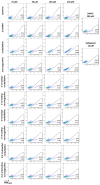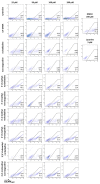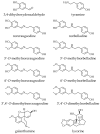Chemical Synthesis and Biological Activities of Amaryllidaceae Alkaloid Norbelladine Derivatives and Precursors
- PMID: 36080382
- PMCID: PMC9457815
- DOI: 10.3390/molecules27175621
Chemical Synthesis and Biological Activities of Amaryllidaceae Alkaloid Norbelladine Derivatives and Precursors
Abstract
Amaryllidaceae alkaloids (AAs) are a structurally diverse family of alkaloids recognized for their many therapeutic properties, such as antiviral, anti-cholinesterase, and anticancer properties. Norbelladine and its derivatives, whose biological properties are poorly studied, are key intermediates required for the biosynthesis of all ~650 reported AAs. To gain insight into their therapeutic potential, we synthesized a series of O-methylated norbelladine-type alkaloids and evaluated their cytotoxic effects on two types of cancer cell lines, their antiviral effects against the dengue virus (DENV) and the human immunodeficiency virus 1 (HIV-1), and their anti-Alzheimer’s disease (anti-cholinesterase and -prolyl oligopeptidase) properties. In monocytic leukemia cells, norcraugsodine was highly cytotoxic (CC50 = 27.0 μM), while norbelladine was the most cytotoxic to hepatocarcinoma cells (CC50 = 72.6 μM). HIV-1 infection was impaired only at cytotoxic concentrations of the compounds. The 3,4-dihydroxybenzaldehyde (selectivity index (SI) = 7.2), 3′,4′-O-dimethylnorbelladine (SI = 4.8), 4′-O-methylnorbelladine (SI > 4.9), 3′-O-methylnorbelladine (SI > 4.5), and norcraugsodine (SI = 3.2) reduced the number of DENV-infected cells with EC50 values ranging from 24.1 to 44.9 μM. The O-methylation of norcraugsodine abolished its anti-DENV potential. Norbelladine and its O-methylated forms also displayed butyrylcholinesterase-inhibition properties (IC50 values ranging from 26.1 to 91.6 μM). Altogether, the results provided hints of the structure−activity relationship of norbelladine-type alkaloids, which is important knowledge for the development of new inhibitors of DENV and butyrylcholinesterase.
Keywords: Alzheimer’s disease; Amaryllidaceae alkaloid; O-methylation; anti-cholinesterase; antiviral; dengue virus; galanthamine; norbelladine; specialized metabolism.
Conflict of interest statement
The authors declare no conflict of interest.
Figures








Similar articles
-
Synthesis, Characterization, and Biological Evaluation of N-Methyl Derivatives of Norbelladine.Molecules. 2024 Sep 19;29(18):4442. doi: 10.3390/molecules29184442. Molecules. 2024. PMID: 39339437 Free PMC article.
-
Substrate Flexibilities of Norbelladine Synthase and Noroxomaritidine/Norcraugsodine Reductase for Hydroxylated and/or Methoxylated Aldehydes.Chem Pharm Bull (Tokyo). 2024;72(5):507-511. doi: 10.1248/cpb.c24-00174. Chem Pharm Bull (Tokyo). 2024. PMID: 38811194
-
Amaryllidaceae Alkaloids of Norbelladine-Type as Inspiration for Development of Highly Selective Butyrylcholinesterase Inhibitors: Synthesis, Biological Activity Evaluation, and Docking Studies.Int J Mol Sci. 2021 Aug 2;22(15):8308. doi: 10.3390/ijms22158308. Int J Mol Sci. 2021. PMID: 34361074 Free PMC article.
-
A mini-review of the anti-SARS-CoV-2 potency of Amaryllidaceae alkaloids.Phytomedicine. 2024 Jul;129:155576. doi: 10.1016/j.phymed.2024.155576. Epub 2024 Mar 29. Phytomedicine. 2024. PMID: 38579643 Review.
-
Amaryllidaceae and Sceletium alkaloids.Nat Prod Rep. 2019 Oct 16;36(10):1462-1488. doi: 10.1039/c8np00055g. Nat Prod Rep. 2019. PMID: 30707215 Review.
Cited by
-
Synthesis, Characterization, and Biological Evaluation of N-Methyl Derivatives of Norbelladine.Molecules. 2024 Sep 19;29(18):4442. doi: 10.3390/molecules29184442. Molecules. 2024. PMID: 39339437 Free PMC article.
-
Comparative Analysis of Primary and Secondary Metabolites in Different In Vitro Tissues of Narcissus tazetta var. chinensis.ACS Omega. 2024 May 23;9(22):23761-23771. doi: 10.1021/acsomega.4c01735. eCollection 2024 Jun 4. ACS Omega. 2024. PMID: 38854557 Free PMC article.
-
Elucidating the enzyme network driving Amaryllidaceae alkaloids biosynthesis in Leucojum aestivum.Plant Biotechnol J. 2025 Jun;23(6):1988-2005. doi: 10.1111/pbi.70026. Epub 2025 Mar 4. Plant Biotechnol J. 2025. PMID: 40035234 Free PMC article.
-
Transcriptomics and network pharmacology analysis reveal key genes in alkaloid biosynthesis in Zephyranthes candida and therapeutic targets for LIHC.Planta. 2025 Jul 10;262(2):45. doi: 10.1007/s00425-025-04756-4. Planta. 2025. PMID: 40640563
-
Antiviral alkaloids from Crinum jagus: Extraction, synergistic effects, and activity against dengue virus and human coronavirus OC43.Heliyon. 2025 Feb 8;11(4):e42580. doi: 10.1016/j.heliyon.2025.e42580. eCollection 2025 Feb 28. Heliyon. 2025. PMID: 40028517 Free PMC article.
References
MeSH terms
Substances
Grants and funding
LinkOut - more resources
Full Text Sources

